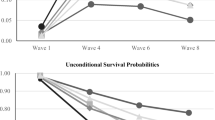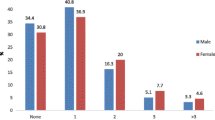Abstract
Objective
Our objective was to investigate change in prevalence rates for mental and substance abuse disorders between early adolescence and young adulthood in a cohort of indigenous adolescents who participated in an 8-year panel study.
Method
The data are from a lagged, sequential study of 671 indigenous adolescents (Wave 1) from a single culture in the Northern Midwest USA and Canada. At Wave 1 (mean age 11.3 years, Wave 4 (mean age 14.3 years), Wave 6 (mean age 16.2 years), and at Wave 8 (mean age 18.3 years) the tribally enrolled adolescents completed a computer-assisted personal interview that included DISC-R assessment for 11 diagnoses. Our yearly retention rates by diagnostic wave were: Wave 2, 94.7 %; Wave 4, 87.7 %; Wave 6, 88.0 %; Wave 8, 78.5 %.
Results
The findings show a dramatic increase in lifetime prevalence rates for substance use disorders. By young adulthood, over half had met criteria of substance abuse or dependence disorder. Also at young adulthood, 58.2 % had met lifetime criteria of a single substance use or mental disorder and 37.2 % for two or more substance use or mental disorders. The results are compared to other indigenous diagnostic studies and to the general population.
Conclusions
A mental health crisis exists within the indigenous populations that participated in this study. Innovations within current mental health service systems are needed to address the unmet demand of adolescents and families.
Similar content being viewed by others
References
Beals J, Manson SM, Whitesell NR, Spicer P, Novins DK, Mitchell CM (2005) Prevalence of DSM-IV disorders and attendant help-seeking in 2 American Indian reservation populations. Arch Gen Psychiatry 62(1):99–108
Costello EJ, Angold A, Burns BJ et al (1996) The Great Smoky Mountains study of youth: goals, design, methods, and the prevalence of DSM-III-R disorders. Arch Gen Psychiatry 53(12):1129–1136
Beals J, Piasecki J, Nelson S et al (1997) Psychiatric disorder among American Indian adolescents: prevalence in Northern Plains youth. J Am Acad Child Psychiatry 36(9):1252–1259
Whitbeck LB, Yu M, Johnson KD, Hoyt DR, Walls ML (2008) Diagnostic prevalence rates from early to mid-adolescence among indigenous adolescents: first results from a longitudinal study. J Am Acad Child Psychiatry 47(8):890–900
Angold A, Costello E (2001) The epidemiology of depression in children and adolescents. In: Goodyer I (ed) The depressed child and adolescent, 2nd edn. Cambridge University Press, New York, pp 143–178
Harrington R, Fudge H, Rutter M, Pickles A, Hill J (1990) Adult outcomes of childhood and adolescent depression: I. Psychiatric status. Arch Gen Psychiatry 47(5):465–473
Lewinsohn P, Rohde P, Klein D, Seeley J (1999) Natural course of adolescent major depressive disorder: I. Continuity into young adulthood. J Am Acad Child Adolesc Psychiatry 38(1):56–63
American Psychiatric Association (2000) Diagnostic and statistical manual of mental disorders, fourth edition, text revision. American Psychiatric Association, Washington
Shaffer D, Schwab-Stone M, Fisher P et al (1993) The diagnostic interview schedule for children—revised version (DSC-R): I preparation, field testing, interrater reliability, and acceptability. J Am Acad Child Psychiatry 32(3):643–650
Shaffer D, Schwab-Stone M, Fisher P et al (1988) A revised version of the diagnostic interview schedule for children DISC-R): results of a field trial and proposals for a new instrument (DISC-2). Epidemiology and Psychopathology Research Branch, Division of Clinical Research, National Institute on Mental Health, Rockville
Schwab-Stone ME, Schwab D, Dulcan MK et al (1996) Criterion validity of the NIMH diagnostic interview schedule for children version 2.3 (DIS-2.3). J Am Acad Child Psychiatry 35(7):878–888
Shaffer D, Fisher P, Dulcan MK et al (1996) The NIMH diagnostic interview schedule for children version 2.3 (DISC-2.3): description, acceptability, prevalence rates, and performance in the MECA study. Methods for the epidemiology of child and adolescent mental disorders study. J Am Acad Child Psychiatry 35(7):865–877
Jensen P, Roper M, Fisher P et al (1995) Test–retest reliability of the diagnostic interview schedule for children (DISC 2.1) parent, child, and combined algorithms. Arch Gen Psychiatry 52(1):61–71
Jensen PS, Rubio-Stipec M, Canino G et al (1999) Parent and child contributions to diagnosis of mental disorder: are both informants always necessary? J Am Acad Child Psychiatry 38(12):1569–1579
Whitbeck LB, Hoyt D, Johnson K, Chen X (2006) Mental disorders among parents/caretakers of American Indian early adolescents in the northern midwest. Social Psychiatry Psychiatr Epidemiol 41(8):632–640
Whitbeck L, Yu M, Johnson K, Hoyt D, Walls M (2008) Diagnostic prevalence rates from early to mid-adolescence among indigenous adolescents: first results from a longitudinal study. J Am Acad Child Adolesc Psychiatry 47(8):890–900
Bird HR, Gould MS, Staghezza B (1992) Aggregating data from multiple informants in child psychiatry epidemiological research. J Am Acad Child Psychiatry 31(1):78–85
Kessler RC, Berglund P, Demler O, Jin R, Merikangas KR, Walters EE (2005) Lifetime prevalence and age-of-onset distributions of DSM-IV disorders in the National Comorbidity Survey Replication. Arch Gen Psychiatry 62(6):593–602
Kessler RC, Chiu WT, Demler O, Walters EE (2005) Prevalence, severity and comorbidity of twelve-month DSM-IV disorders in the National Comorbidity Survey Replication. Arch Gen Psychiatry 62(6):612–627
Bachman JG, Wallace JM, O’Malley PO et al (1991) Racial/ethnic differences in smoking, drinking, and illicit drug use among American high school seniors, 1967–1989. Am J Pub Health 81(3):372–377
Blum RW, Harmon B, Harris L et al (1992) American Indian–Alaska native youth health. JAMA 267(12):1637–1644
Cheadle JE, Whitbeck LB (2011) Alcohol use trajectories and problem drinking over the course of adolescence: a study of North American indigenous youth and their caretakers. J Health Soc Behav 52(2):228–245
Dingwall KM, Cairney S (2010) Psychological and cognitive assessment of indigenous Australians. Aust N Z J Psychiatry 44(1):20–30
Armenta BE, Sittner Hartshorn KJ, Whitbeck LB, Crawford DM, Hoyt DR. A longitudinal examination of the measurement properties and predictive utility of the center for epidemiologic studies depression scale among North American indigenous adolescents. Psychol Assess (in press)
Acknowledgments
This research was funded by the National Institute on Drug Abuse (DA13580) and the National Institute of Mental Health (MH67281).
Conflict of interest
On behalf of all authors, the corresponding author states that there is no conflict of interest.
Author information
Authors and Affiliations
Corresponding author
Appendix
Appendix
See Appendix Table 5.
Rights and permissions
About this article
Cite this article
Whitbeck, L.B., Sittner Hartshorn, K.J., Crawford, D.M. et al. Mental and substance use disorders from early adolescence to young adulthood among indigenous young people: final diagnostic results from an 8-year panel study. Soc Psychiatry Psychiatr Epidemiol 49, 961–973 (2014). https://doi.org/10.1007/s00127-014-0825-0
Received:
Accepted:
Published:
Issue Date:
DOI: https://doi.org/10.1007/s00127-014-0825-0




